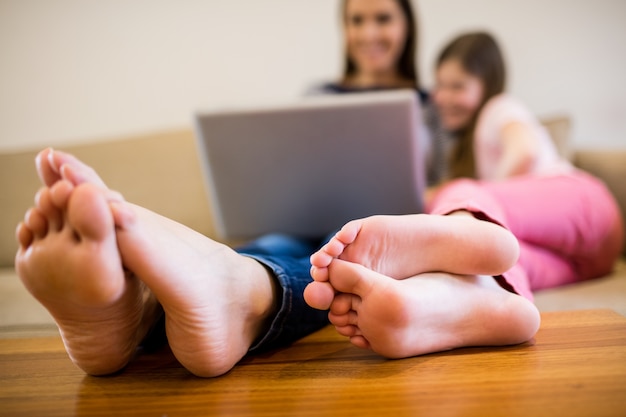
When your child complains of foot or ankle pain, it can be upsetting and worrisome. Common foot issues in kids can be a real challenge for parents. It’s important to understand that there’s no such thing as “growing pains” in this context—pain that lasts longer than a couple of days, limits mobility, or seems severe should always be checked by a doctor. Let’s take a look at some common foot problems in children and how they can be addressed.
### Common Foot Health Issues in Children
—
#### Flat Feet (Pediatric Flatfoot)
Flat feet, or fallen arches, are quite common among young children. Most kids with flat feet don’t show visible symptoms, but some may have trouble participating in sports or physical activities, walking, or running in what seems like an unusual manner. Others might experience pain or cramping in their legs, knees, or feet. If your child is experiencing any of these issues, it’s essential to consult a doctor for evaluation.
Flat feet are normal in babies because their bones and joints are still incredibly flexible. Many infants also have hidden arches that are obscured by fat pads on their feet. Typically, this condition resolves by the age of six as the feet stiffen and arches begin to form. Only one or two out of ten children carry flat feet into adulthood, and most cases don’t require treatment unless they involve pain or stiffness. Shoe inserts won’t help build arches and could actually cause complications. However, there are exercises and treatments available for specific cases, such as those involving a tight Achilles tendon or rigid flat feet, both of which require medical attention.
#### Sever’s Disease (Heel Pain from Growth Plate Inflammation)
Sever’s disease, or calcaneal apophysitis, is a common heel-related condition in children aged 8–14. This occurs because the growth plate in the heel (calcaneus) isn’t fully developed and can become irritated due to repetitive strain, especially during activities like running or jumping. Symptoms usually include heel pain, which worsens with activity.
#### Ingrown Toenails
Ingrown toenails often occur when nails are trimmed improperly or a child is wearing tight socks or shoes. Genetics can also play a role. If the nail grows into the skin, it can cause infection, which shouldn’t be handled at home; this requires professional medical attention.
#### Plantar Warts
Caused by the human papillomavirus (HPV), plantar warts are common among kids and typically develop on the bottom of the feet. These can make walking and standing uncomfortable.
#### Heel Pain
Heel pain isn’t just an adult issue—it also affects children and teens. It’s important to distinguish regular growing pains from heel pain caused by other underlying conditions. Mild or short-term growing pains are common, but if the pain persists, worsens, or limits activity, there might be a more serious issue.
#### Achilles Tendonitis
Achilles tendonitis occurs when there’s strain on the Achilles tendon due to increased physical activity or growth spurts. This leads to pain, especially during running or jumping, and children may also experience stiffness in the morning.
#### Bursitis
Bursitis involves pain and inflammation near the area where the Achilles tendon attaches to the heel. It’s caused by irritation or stress, often from tight shoes or repetitive movement.
#### Plantar Fasciitis
Pain in the bottom of the heel may be linked to plantar fasciitis, which is caused by inflammation of the tissues connecting the heel to the toes. Issues like flat feet or high arches can make this condition worse. Pain is often worse in the mornings or after a day of physical activity.
#### Pigeon Toes (In-Toeing)
Pigeon toes happen when a child’s feet naturally turn inward. This is very common in young children and generally doesn’t require medical treatment. Most kids outgrow this condition as they develop.
#### Bowlegs
Bowlegs occur when a child’s knees are wide apart while their ankles are close together. It’s normal for babies to be born bowlegged due to their position in the womb, and the legs typically straighten out over time as the child grows. However, if the bowing persists beyond age two or is seen only in one leg, it could indicate a more serious issue like rickets or Blount disease, both of which may require medical treatment.
#### Knock Knees
Knock knees, in which the knees angle inward while the ankles stay apart, often appear around ages 3–6 and usually resolve without intervention. In rare cases where the condition causes pain or impacts walking, medical treatment might be necessary. Surgery is only considered in extreme cases.
#### Toe Walking
It’s common for toddlers to toe-walk as they’re learning to walk. Most children outgrow this habit by age three. However, persistent toe walking beyond this age may be linked to underlying conditions like muscle weakness or neurological issues, such as cerebral palsy or autism. Physical therapy and stretching exercises can help, and in some cases, casting may be recommended.
#### In-Toeing
In-toeing often becomes noticeable when a child begins to walk. It can happen for several reasons, such as an inward rotation of the lower leg (tibial torsion) or a twist in the upper thigh bone (femoral anteversion). Most children outgrow in-toeing without intervention. In rare cases, this condition may be associated with other medical conditions and should be evaluated by a physician.
—
### Additional Considerations
In some cases, persistent pain or discomfort in your child’s feet may stem from inflammatory conditions (like juvenile arthritis), bone fusions (such as tarsal coalitions), or less common causes like cysts or tumors. These issues require a thorough evaluation by a pediatric specialist.
—
### Conclusion
Children’s foot and heel problems are quite common, though many resolve on their own as kids grow. However, if your child is experiencing pain, difficulty walking, or other concerning symptoms, don’t hesitate to seek help from a pediatric specialist or podiatrist. Early evaluation and treatment can help keep your child comfortable and active.